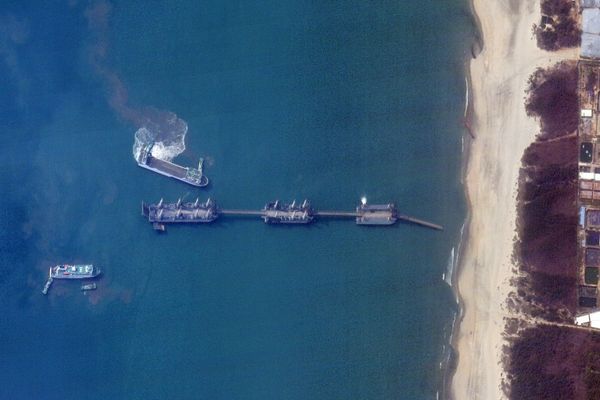/https://static.texastribune.org/media/files/2789595a411d3cbaa5aa23560f84e1c5/0229%20Panhandle%20Fire%20MR%2018.jpg)
A series of wildfires in the Panhandle, which first broke out Monday afternoon, have engulfed more than 1 million acres of land — an area larger than the state of Rhode Island – making it the largest fire in Texas history.
At least two people have died, four firefighters were injured and many have been evacuated or ordered to seek shelter.
[New Panhandle wildfire emerges, forcing evacuation of tiny town of Sanford]
Firefighters continue to try to quell the wildfires, some of which were still spreading on Thursday, before warm, windy and dry conditions are expected to return during the weekend. The National Weather Service on Friday afternoon heightened its alerts for many parts of the Panhandle, warning those conditions will create "favorable weather for rapid fire growth and spread" and asked people to "avoid activities that promote open flames and sparks."
Gov. Greg Abbott on Wednesday issued a disaster declaration for 60 counties in the area, directing the Texas Division of Emergency Management to deploy more resources and firefighters to contain the blaze. Additional medical personnel are also on the ground to support firefighters and other emergency responders.
Here’s more about what alerts have been issued, wildfire safety, what we know about damages, and how you may be able to help affected Texans.
How to get mental health support amid wildfires
It is normal for people to experience shock in the immediate aftermath of a disaster. People like those with existing mental health conditions may see increased symptoms of stress. Others may focus on recovery and relief efforts but may feel symptoms of stress and trauma later on, according to experts.
Symptoms can include aches, trouble sleeping, changes in appetite, losing motivation, getting frustrated more frequently and feeling overwhelmed, sad, numb, lonely and physically or mentally drained.
Most emotional responses and stress symptoms are temporary, but if they persist for two weeks or longer, it is recommended to seek help. Signs of greater emotional distress can include feeling hopeless, feeling guilty without being sure why, having difficulty readjusting to home and work life, excessive smoking, drinking or drug use or thinking of hurting yourself or someone else, according to the federal Substance Abuse and Mental Health Services Administration (SAMHSA).
SAMHSA runs the Disaster Distress Helpline to provide support to people experiencing emotional distress related to disasters, including wildfires. The helpline operates year-round, 24 hours a day and is free and confidential. You can call or text 800-985-5990 to be connected with a trained crisis counselor who can provide counseling, healthy coping tips and more information on signs of emotional distress. Crisis counselors can also refer you to local resources for additional support.
Families and individuals affected by the wildfires can also reach out to the AgriStress Helpline, which provides free and confidential support 24 hours a day through crisis specialists who have received training on the factors that impact people working in agriculture. You can call or text the helpline at 833-897-2474.
Trained crisis counselors are also available through the national Suicide and Crisis Lifeline by calling or texting 988.
Read more tips about how to take care of your mental health during natural disasters here.
How to help those affected by wildfires
The Amarillo Area Foundation’s Panhandle Disaster Relief Fund, which supports local residents and organizations, is accepting donations online or by check.
The Texas Farm Bureau has established a fund to help farmers and ranchers affected by the Panhandle wildfires. Donations are being accepted online and by check. Agricultural producers can apply for assistance through this form.
The Texas A&M AgriLife Extension Service is establishing supply points in several locations in the region to accept donations of hay, feed and fencing supplies needed to support ranchers and producers affected by the wildfires. Here’s how to donate to specific areas. General questions about donations or relief efforts can be made at 806-354-5800, according to Texas A&M AgriLife Extension Service.
The Texas Panhandle Volunteer Organizations Active in Disaster (VOAD) is helping coordinate volunteering in the area. You can fill out their volunteer interest form here, email info@txpanhandlevoad.org or call 806-378-3004.
Here are more guides from news outlets with information on how to get involved:
- How to help: Ways to provide assistance after wildfires impact West Texas, Lubbock Avalanche-Journal
- How to support Texas wildfire victims from afar, KXAN
- High Plains communities, fire departments, agencies advise how to help first responders amid wildfires, MyHighPlains.com
- How to help the Texas Panhandle wildfire victims, Fox4
Evacuations and damages
On Tuesday, local officials in the cities of Canadian, Fritch and Glazier ordered nearly 5,000 residents to evacuate or shelter in place. By Wednesday, the evacuation order in Hemphill County, where Canadian and Glazier are located, was lifted.
Local officials are still assessing the extent of the damage, but the fires destroyed approximately 40 homes near Canadian, according to early estimates by Hemphill County Emergency Management coordinator Bill Kendall.
Local officials are working to clear up roadblocks and set up donation centers, according to the Canadian Record, which has provided periodic updates on social media.
The Texas Division of Emergency Management has asked people whose property has been damaged by the wildfires to report the damages through an online survey to help officials "understand the extent of damages & identify immediate resource needs."
The storage company U-Haul is offering 30 days of free self-storage and container usage to residents affected by the wildfires across the Panhandle, according to a company press relase.
Wildfire safety tips
Smoke from wildfires alone can pose a serious health threat, especially for kids, older adults and those with chronic heart or lung disease and asthma.
Exposure to wildfire smoke can trigger asthma attacks, heart attacks and strokes. It can cause eye and respiratory irritation, coughing, wheezing and difficulty breathing.
Wildfires can also create a risk of carbon monoxide poisoning. Inhaling carbon monoxide can cause headaches, nausea, dizziness and, in high concentrations, premature death.
Fires and natural disasters can also expose asbestos fibers used in the construction of older buildings. Workers and people who breathed in asbestos over many years have developed serious or fatal conditions, including cancers. Materials that may have asbestos include paint, roofing, flooring and insulation.
Texans can find information about local wildfires through their local fire departments or online using the Texas A&M Forest Service’s Incident Viewer.
What to do during a wildfire:
- Close all windows, vents, doors, and fireplace screens.
- Disconnect automatic garage door openers so doors can be opened by hand if you lose power
- Close and protect all of your home’s openings to prevent embers from penetrating your home
- Place valuable documents and family mementos inside the car for quick departure if necessary
- Connect garden hoses and fill any pools, hot tubs, garbage cans, tubs, or other large containers with water. Firefighters have been known to use the hoses to put out fires on rooftops.
- Evacuate immediately if authorities tell you to do so and leave the lights on in your home so that firefighters can see it through dense smoke
What to do after a wildfire
- Wait for officials to say it’s safe before returning home or using water
- Avoid ash, charred trees, smoldering debris, and live embers
- Avoid damaged or fallen power lines, poles, and downed wires
- Follow public health rules and wear safety equipment
- Protect your skin with long-sleeved clothing and wear goggles to protect your eyes
- Wear an N95 respirator and don’t breathe in ash
- Wash off ash that gets on your skin or in your eyes or mouth as soon as you can
- Wet or cover asbestos-related debris to minimize dust, and always wear additional protective gear, such as boots and gloves during removal
- If there is asbestos, check estate regulations for the removal and management of asbestos materials
- Document property damage with photographs and contact your insurance company
SOURCES: The Centers for Disease Control and Prevention, Environmental Protection Agency, Ready.gov (U.S. Department of Homeland Security), American Red Cross, National Weather Service, Coronado National Forest, USDA Forest Service, Texas General Land Office, The Mesothelioma Center
Wildfire weather alerts
The National Weather Service centers in Amarillo and Lubbock on Friday issued red flag warnings for most of Saturday and Sunday evening, replacing previous fire weather watches.
Weather forecasters issue a fire weather watch when potentially dangerous fire weather conditions are possible over the next 12 to 72 hours.
A fire weather warning or red flag is issued when dangerous fire weather conditions are either occurring or expected to occur within 24 hours. If the danger is imminent, local authorities may issue an evacuation notice to alert residents.
Forecasters in Lubbock said the red flag warning was in effect for strong winds and low humidity for all of the South Plains and the Far Southern Texas Panhandle from 11 am to 7 pm Saturday and Sunday.
Forecasters in Amarillo said the red flag warning for the Texas and Oklahoma Panhandle was in effect from Saturday afternoon through Sunday evening and included the following counties:
- Dallam
- Sherman
- Hansford
- Ochiltree
- Lipscomb
- Hartley
- Moore
- Hutchinson
- Roberts
- Hemphill
- Oldham
- Potter
- Carson
- Gray
- Wheeler
- Deaf Smith
- Randall
- Armstrong
- Donley
- Collingsworth
- Palo Duro Canyon (State Park)
Disclosure: Texas A&M AgriLife, Texas A&M AgriLife Extension Service, Texas Farm Bureau and Texas General Land Office have been financial supporters of The Texas Tribune, a nonprofit, nonpartisan news organization that is funded in part by donations from members, foundations and corporate sponsors. Financial supporters play no role in the Tribune's journalism. Find a complete list of them here.







